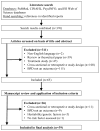A systematic review of risk factors prospectively associated with borderline personality disorder: Taking stock and moving forward
- PMID: 27709988
- PMCID: PMC5055059
- DOI: 10.1037/per0000186
A systematic review of risk factors prospectively associated with borderline personality disorder: Taking stock and moving forward
Abstract
There is an urgent need to identify signs that harbinger onset of borderline personality disorder (BPD). Advancement in this area is required to refine developmental theories, discover etiological mechanisms, improve early detection, and achieve our ultimate goal of prevention. Though many studies have supported a wide range of factors that increase subsequent risk for BPD, this literature has yet to be critically evaluated, and there are no comprehensive reviews that examine and integrate these findings. To address this limitation, we conducted a systematic review to summarize and synthesize the current literature. Electronic databases were systematically searched for prospective, longitudinal studies that examined risk factors of subsequent BPD outcomes (features, symptoms, diagnosis), resulting in a total of 39 studies, reflecting 24 unique samples. Though increased risk for BPD was reliably attributed to multiple factors within social, family, maltreatment, and child domains, the most striking limitation of this research is its lack of disorder-specific findings. Additional limitations, including notable heterogeneity in sampling methodology, symptom assessment methodology, and developmental timing of assessments, are discussed in terms of how close we are to pinpointing who is most at risk and why in an attempt to provide a roadmap for future research. (PsycINFO Database Record
(c) 2016 APA, all rights reserved).
Figures

References
-
- Bagge C, Nickell A, Stepp SD, Durrett C, Jackson K, Trull TJ. Borderline personality disorder features predict negative outcomes 2 years later. Journal of Abnormal Psychology. 2004;113(2):279–288. - PubMed
-
- Chanen AM. Borderline personality disorder in young people: Are we there yet? Journal of Clinical Psychology. 2015;71(8):778–791. - PubMed
-
- Cicchetti D, Rogosch FA. Equifinality and multifinality in developmental psychopathology. Development and Psychopathology. 1996;8(4):597–600.
-
- Eaton WW, Badawi M, Melton B. Prodromes and precursors: epidemiologic data for primary prevention of disorders with slow onset. The American Journal of Psychiatry. 1995;152(7):967. - PubMed
Publication types
MeSH terms
Grants and funding
LinkOut - more resources
Full Text Sources
Other Literature Sources

